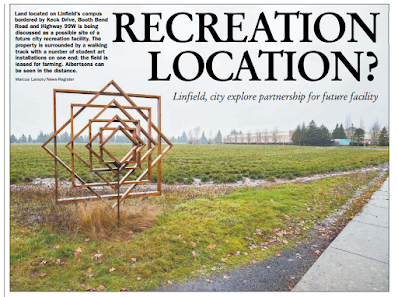By Dora
Totoian, McMinnville N-R/News-Register Dec. 15, 2020
The city of McMinnville and Linfield University
have agreed to explore siting the city’s future recreation facility on
Linfield-owned land adjacent to its campus.
Linfield President Miles Davis and city manager
Jeff Towery announced the potential partnership at Thursday’s MacPac meeting,
saying they have gotten only as far as being open to consider all
opportunities.
“Being in education is a unique position and it
is a trust for a town,” Davis said. “Every once in a while, you get an
opportunity to blue sky something.”
The university released a statement Thursday
saying it and the city have agreed to sign a memorandum of understanding to
begin preliminary discussions.
“If the right deal came together that benefited
Linfield and met the city’s needs, we would consider it,” said Mary Ann
Rodriguez, Linfield’s chief financial officer and vice president for
administration. “But we’re a long way from that. These talks are very, very
early-stage.”
The new facility would be located on the 80-acre
parcel of land bounded by Highway 99, Booth Bend Road, Keck Drive and the
Linfield campus. The land, currently leased for farming, was donated to the
college by Hewlett-Packard after Linfield purchased the company’s adjacent
plant buildings and 17 acres for $4.2 million.
While the initial agreement doesn’t commit the
city to a final decision on a partnership with Linfield, Towery said he’ll do
everything possible to make it happen. Davis concurred. Towery said Monday it
was Linfield that initially approached the city about the possible
collaboration.
MacPac is a 19-person city advisory committee
formed last year to develop plans for renovating current facilities or building
new ones, including a community center, aquatic center and library. It is
tasked with identifying a location, programming and design for a single
facility or facilities, and making a recommendation to the city council.
Parks and Recreation Director Susan Muir
emphasized that MacPac must analyze this possible location through a long list
of criteria to ensure it meets community needs, a task it will begin in
January. Having a potential location identified will also help guide the rest
of the group’s work, Muir said.
“This is a really exciting prospect, and I look
forward to going through the conversations, and MacPac will do the analysis
before we take it to the public,” she said.
It is vague how MacPac’s work will change with
Linfield in the equation and how facility operations and finances would be
shared. Councilor Zack Geary, a member of MacPac, emphasized the group still
has an important role in seeking to understand what the community prefers for
its new recreation facility.
Davis and Towery highlighted the opportunity for
more than just a combined community and aquatic center on the property,
including the potential for a performing arts venue and other community spaces.
However, Geary made a point to tell MacPac
members the mission remains to first meet the critical needs of the city.
MacPac member Lisa Macy-Baker, a former
tennis coach at Linfield and McMinnville High School, thinks
a public-private partnership would be advantageous for both the city and
university.
“It’s always positive to have a symbiotic
relationship with Linfield,” she said. “I do think it’s a solid location in
terms of its size and the potential to think real big, to think beyond even
what we’ve maybe been thinking.”
She added, “There’s so much unknown right now
that you have to proceed with optimism and then go from there.”
Kevin Chambers, a managing partner at Headwater
Investments, said Linfield’s enthusiasm to explore a collaboration surprised
him, although MacPac had discussed it.
MacPac must be mindful as it now dreams bigger,
Chambers said. Not everyone may feel comfortable venturing onto a university
campus, he said.
“I think it’s a really cool program...as Dr.
Davis said, one of the goals is to integrate people more into the Linfield
community,” Chambers said. “We need to be aware that this is a city and
Linfield partnership, it’s not just a Linfield building getting built.”
Davis and Towery said the city is trying to
include a diversity, equity and inclusion framework as it pursues this
partnership. They appreciate the location because it’s on Highway 99, has a bus
stop nearby, and can easily be wheelchair-accessible, among other reasons.
Mayor Scott Hill said he considers the Linfield
site a prime location, and it could build support for a possible bond that may
be required to fund the project.
“When we talk about a legacy project, it’s in a
legacy location,” Hill said. “When you’re looking at a bond and the efforts
that go on from that perspective...it takes a heavy lifting and it needs
passion from people who go out and tell the story.”
Sara Tucholsky, a substitute teacher and MacPac
member, highlighted the opportunity for the city to help develop an important
piece of property. Davis noted at Thursday’s meeting how Linfield easily
could sell the land to a big-box store, but this option would allow a much
different path.
Tucholsky said other locations being
considered would cut into green space in parks; this one doesn’t. Some people
expressed concern about losing the walking trail on the property, but she
envisions MacPac would try to replace it with an enhanced trail.
The need for ongoing community engagement with
the committee was stressed by MacPac members.
“This end of town has a lot of potential. This
is a way for the community to have a hand in what this side of town looks
like,” Tucholsky said. “My only concern right now is just that the community
understands that MacPac serves a role for them.”

